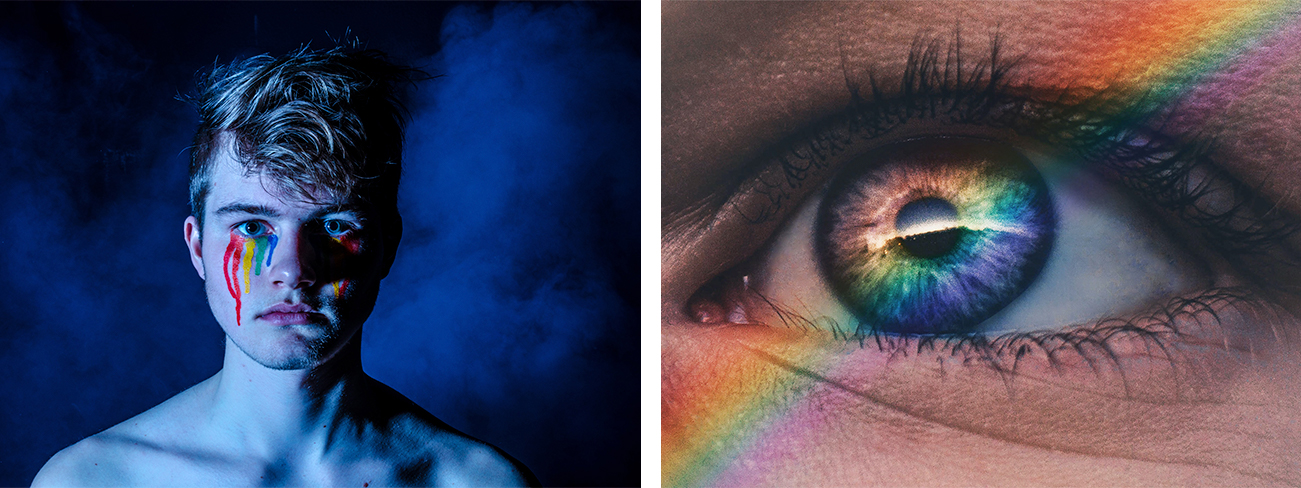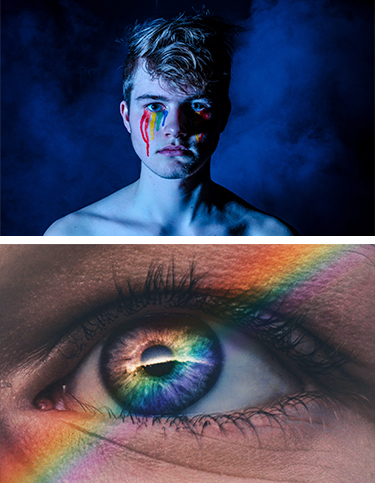LGBTQ Youth Mental Health: New Research and Statistics
Reading Time: 5 minutesYoung adults have been hit harder than any other age group by the psychological, political, economic, and social repercussions of the last two years. And within this demographic, young people who identify as LGBTQ have been even more drastically impacted. A new Trevor Project survey on LGBTQ youth mental health found that 64 percent of LGBTQ young adults are experiencing symptoms of anxiety, and 50 percent are suffering from depression. For transgender and nonbinary young adults, LGBTQ depression rates are even higher.
These troubling statistics illuminate the struggles LGBTQ young adults face and the pressing need for social change to support these demographics. This includes those with intersectional identities that encompass more than one marginalized identity or group—such as Asian American/Pacific Islander, Black, Indigenous, Latinx, or multiracial LGBTQ youth. LGBTQ young adults need tools for resilience and well-being more than ever before.
Key Takeaways
- Suicide rates and mental health issues among LGBTQ young adults are higher on average than among straight, cisgender peers.
- Research shows that rates of alcohol use among LGBTQ young adults (ages 18–25) are also higher than their peers.
- LGBTQ youth suffer from mental health issues in large part due to being mistreated and stigmatized in society, as well as by family.
- External and internal resources can support the well-being of LGBTQ young adults.
New Research on LGBTQ Youth Mental Health
The Trevor Project’s 2023 survey of more than 28,000 young people provides a window into LGBTQ youth mental health and LGBTQ youth suicide rates. Here is a sampling of the findings:
- 1 in 3 LGBTQ young adults (ages 18–24) considered suicide during the past year, and about 1 in 10 made a suicide attempt.
- 22 percent of Native/Indigenous LGBTQ youth and 10 percent of Black LGBTQ youth made a suicide attempt in the past year.
- Three-quarters of LGBTQ youth have experienced discrimination based on their sexual orientation or gender identity.
- 65 percent of trans youth who were on on gender-affirming hormones reported being somewhat or very concerned about losing access to this care.
Know the Facts
81 percent of LGBTQ youth wanted mental healthcare during the past year, but 56 percent were unable to access any services.
Questions?
All calls are always confidential.
Why Do LGBTQ Youth Have Higher Rates of Mental Health Conditions and Suicide Risk?
It’s important to understand that a young adult’s sexuality and mental health are not directly related. LGBTQ youth mental health suffers not because of their sexual orientation or gender identity in itself. Rather, they face higher risk due to being mistreated and stigmatized in society, as well as by family.
Between 20 and 45 percent of the homeless youth in the United States identify as LGBTQ, and most have left home or been kicked out due to family rejection. And 1 in 4 LGBTQ young people report that they have been physically threatened or harmed in the past year due to their sexual orientation or gender identity, according to the Trevor Project survey. Moreover, the survey found that nearly 1 in 3 LGBTQ young people experienced poor mental health most or all of the time due to anti-LGBTQ policies and legislation.
LGBTQ Substance Abuse Statistics
Not surprisingly, these LGBTQ youth mental health statistics are reflected in rates of substance abuse among LGBTQ young adults. Studies show that this demographic, particularly women, are at greater risk for alcohol and substance use disorders, due to the intensified stressors they face.
Recent research using data from the CDC and the Substance Abuse and Mental Health Services Administration (SAMHSA) shows that rates of alcohol use among LGBTQ young adults (ages 18–25) are 18 percent higher than their peers. Rates of marijuana use are 59 percent higher. Moreover, lifetime usage of harder drugs—including cocaine, meth, ecstasy, and heroin—is two to three times higher among LGBTQ young adults.
Most significant, higher rates of substance abuse in this population are directly associated with higher LGBTQ suicide rates. Regular prescription drug misuse was associated with nearly three times greater odds of attempting suicide. Regular alcohol use was associated with nearly 50 percent higher likelihood of attempting suicide. And LGBTQ youth under age 21 who regularly used marijuana were nearly twice as likely (1.67 times) to attempt suicide.


Resources to Support Mental Health in LGBTQ Youth
These four resources are essential in supporting the mental health and well-being of LGBTQ+ young adults.
Support from family
Parental acceptance and affirmation are the most important predictors of LGBTQ mental health. When they are deprived of that acceptance, young adults suffer from the tragic consequences of relational trauma. One study found that LGBTQ young adults who experienced high levels of family rejection during adolescence were nearly six times as likely to be depressed and three times more likely to use illegal drugs. Trevor Project research shows that LGBTQ youth who feel high social support from family attempt suicide at less than half the rate of those who felt low or moderate social support.
Self-compassion
It sounds simple, but it’s incredibly effective. Research shows that self-compassion and self-empowerment are essential resources for personal happiness—and can even help overcome a lack of parental acceptance. Mindfulness and positive affirmation practices that build empathy and acceptance for oneself are therefore powerful resources for LGBTQ youth mental health.
Supportive communities
Connection is vital for LGBTQ young adults. A review of 34 studies on LGBTQ youth mental health found that community groups and GSAs (Gay-Straight Alliance groups) provided an all-important “sense of solidarity and friendship in the face of isolation.” Feeling connected with the LGBTQ community can even protect young people from the negative outcomes of prejudice, one study found. In addition, caring adults and positive peer connections also serve as invaluable resources.
Self-care
Building healthy habits and routines can take some effort, but once these practices are established, they will continue to support young adults throughout life. Self-care includes not just attending to physical health, but also to mental, emotional, spiritual, and relational well-being—whether that means making a gratitude list or savoring the beauty of the ocean or a gorgeous sunset. And self-care also includes seeking the support of a mental healthcare professional if you’re suffering from anxiety, depression, or suicidal thoughts, rather than trying to tough it out on your own.
Ultimately, despite the challenges they face, developing and drawing on these resources can help LGBTQ young adults fully embrace who they are and find a path forward to flourishing.
Culturally Competent and Gender-Responsive Treatment at Newport Institute
At Newport Institute, we understand the specific challenges that LGBTQ young adults navigate as they come of age. Our treatment takes into account the unique needs of LGBTQ+ youth and adults and provides them with tools for navigating the world, building self-worth, and forming strong relationships with peers, mentors, and their larger community.
Our clinical experts and care staff have expertise and experience in addressing the mental health challenges that LGBTQ+ young people face. Newport has partnered with the Trevor Project, the nation’s foremost LGBTQ+ advocacy and research organization, to provide specialized training for our staff.
Newport Institute’s Admissions experts and Clinical Outreach Specialists are standing by to help LGBTQ young people get the support they need. Contact us today.

